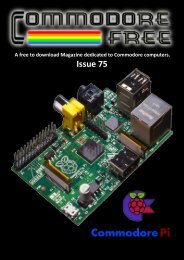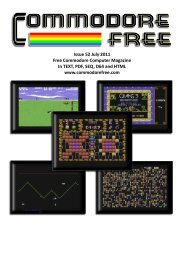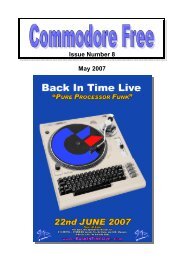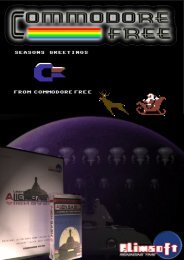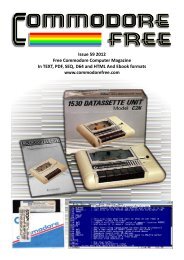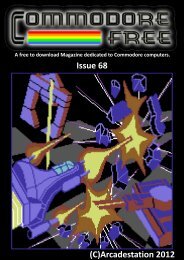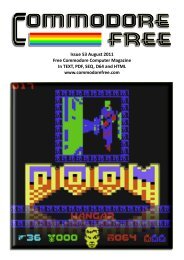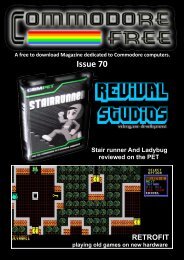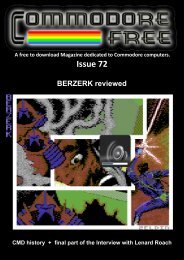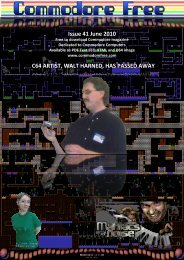Create successful ePaper yourself
Turn your PDF publications into a flip-book with our unique Google optimized e-Paper software.
www.commodorefree.comINTERVIEW WITH LENARD ROACHPART 1: BOOKS<strong>Commodore</strong> <strong>Free</strong> had the chance to contact Lenard Roachand quiz him about his work on and about the <strong>Commodore</strong>.Q: Hey, Lenard! Thanks for taking time out to talk toour readers.A: It's all groovy. I'm chilling with my cats and ready to chat.Q: Let's start with something to ease everyone into theconversation-how long have you been working on the<strong>Commodore</strong>?A: I got my first unit for Christmas in 1987. It was a C64with tape drive and RTF hookup. I burned an image of thehome screen into my JC Penny TV, which was so bad fromconstant computer use that I had to replace it. I wrote myfirst and only movie script, "The Crimebusters," on it. Thescript was so long that it took 30 minutes to load the manuscriptoff the tape drive and into the C64. I used Speedscript3.0 for my word processor back then. Now I use GeoWrite.I started serious BASIC programming in 1991, and finally hitthe "big time" in <strong>Commodore</strong> with "Check it Out" in 1992,the same year my youngest son was born. RUN magazinegave me $150 for 26 blocks of code. It was the thrill of a lifetime.I went <strong>Commodore</strong> crazy from 1995 to 2010 writingdozens and dozens of articles for Ryte Bytes, Loadstar, TheInterface, and The Village Green, along with some more freelanceprogramming.Q: Speaking of writing, let’s look at your two <strong>Commodore</strong>books, "Run/Stop-Restore" and "Run/Stop-Restore:10th Anniversary Edition." Starting with the firstbook, "Run/Stop-Restore," what was the purpose behindthat book?A: "Run/Stop-Restore" is a collection of stories and essaysfrom some of my best writings during 1995 to 2000. I assembledthese pieces together under an inspiration – awhim, if you will – about three days after I got fired from myjob at the detention centre. The assembling, structuring, formatting,printing, and illustrating the book took a month ofworking on for twelve hours a day every day.<strong>Commodore</strong> had dozens of "how to" and "history of" books,but nothing I could find that expressed the emotions and experiencesof working on the machine. Maybe I didn't looktoo hard. I was hoping to come out with the first "what the"book in the <strong>Commodore</strong> genre. Upon opening "Run/Stop-Restore," the reader is met with, not technical data or dates,names, and places, but some fun, tongue in cheek humouralong with the occasional data, and even an illustrationdone by the one of the Roach family that told the story in apicture. The book was divided into eight sections that categorizedthe essays. The cover was illustrated by my theneight-year-old son Gabriel.Q: Yes, the cover to "Run/Stop-Restore" definitelythrows the browser for the book into a loop. I personallywould be looking for a keyboard or something alongthose lines. Can you explain the house on the cover ofthis particular volume?A: Everyone in my family contributed to the book; everyonethat is, except Gabriel. My wife discussed the situation withme, and I thought of the only part of the book that hasn'tbeen done-the cover. I sat Gabriel down and asked him todraw a picture of what <strong>Commodore</strong> meant to him, and what-<strong>Commodore</strong> <strong>Free</strong> <strong>Magazine</strong> Page 29



